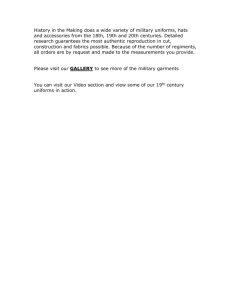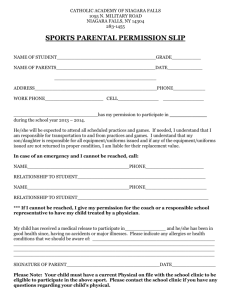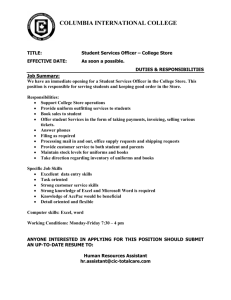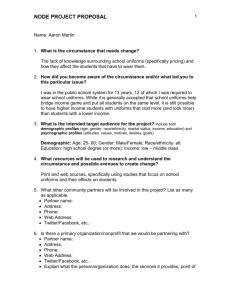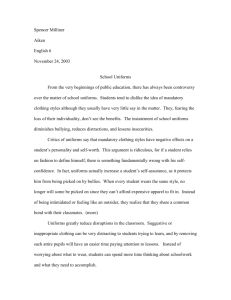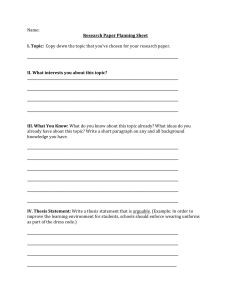Grade 8 Unit 2 EA 2 ARGUMENT JV-2
advertisement
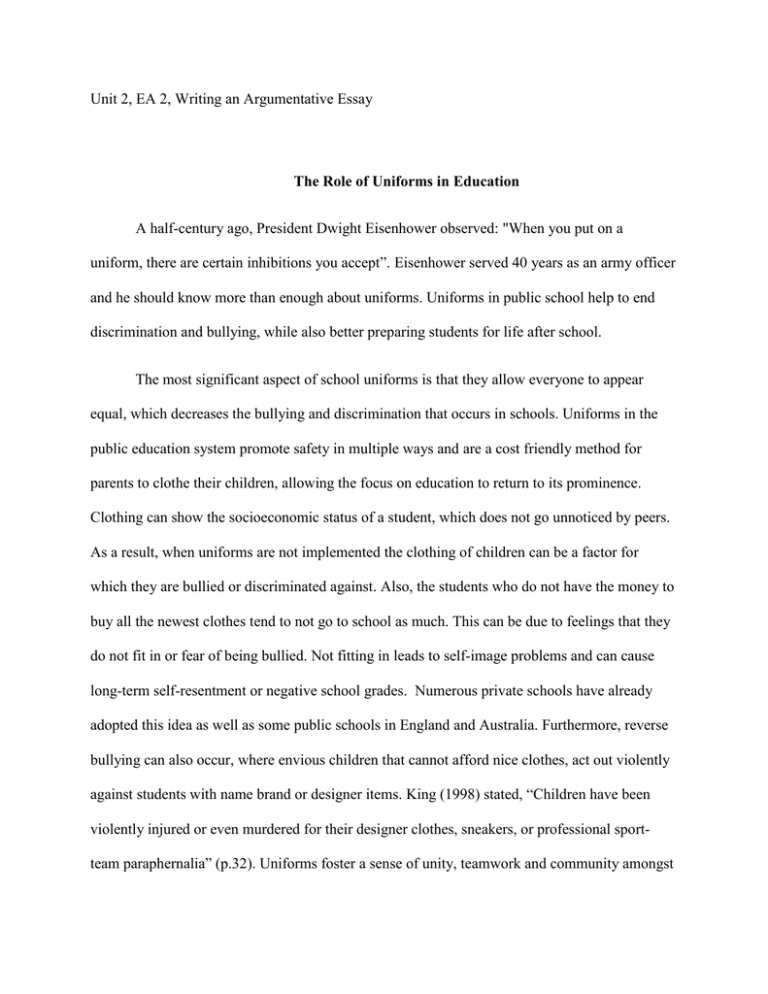
Unit 2, EA 2, Writing an Argumentative Essay The Role of Uniforms in Education A half-century ago, President Dwight Eisenhower observed: "When you put on a uniform, there are certain inhibitions you accept”. Eisenhower served 40 years as an army officer and he should know more than enough about uniforms. Uniforms in public school help to end discrimination and bullying, while also better preparing students for life after school. The most significant aspect of school uniforms is that they allow everyone to appear equal, which decreases the bullying and discrimination that occurs in schools. Uniforms in the public education system promote safety in multiple ways and are a cost friendly method for parents to clothe their children, allowing the focus on education to return to its prominence. Clothing can show the socioeconomic status of a student, which does not go unnoticed by peers. As a result, when uniforms are not implemented the clothing of children can be a factor for which they are bullied or discriminated against. Also, the students who do not have the money to buy all the newest clothes tend to not go to school as much. This can be due to feelings that they do not fit in or fear of being bullied. Not fitting in leads to self-image problems and can cause long-term self-resentment or negative school grades. Numerous private schools have already adopted this idea as well as some public schools in England and Australia. Furthermore, reverse bullying can also occur, where envious children that cannot afford nice clothes, act out violently against students with name brand or designer items. King (1998) stated, “Children have been violently injured or even murdered for their designer clothes, sneakers, or professional sportteam paraphernalia” (p.32). Uniforms foster a sense of unity, teamwork and community amongst students because they share a common identity through their clothes. Additionally, uniforms can help prevent discrimination, gang related clothing colors, and mistaken identities from occurring on campus. Similar dress amongst students would allow for kids to focus on their schoolwork and prevent stress and social anxiety. Some parents dismiss uniforms and feel bullying is not as big of a problem as it has been in the past, due to better teacher-student relationships and more anti-bullying promotions occurring in school. Nevertheless, according to King (1998), “Approximately one in four students reports worrying about becoming a victim of crime or threats at school”. Students should not have to worry about their safety in school at all and uniforms foster a safe and comfortable learning environment for everyone. On the other hand, many parents and children argue against uniforms because they want to allow freedom of expression through dress. Children especially dislike the strict rules that are associated with properly wearing their school uniforms. Parents that are against uniforms in school claim that how a child is dressed does not affect their performance in school. However, according to Craik (2007), studies have shown that schools across America “noted a possible connection between school violence and the type of clothing students wear in school” (p. 37). Moreover, school uniforms better prepare students for life after school where they will be required to dress a certain way for their job. When schools were established in America, one of the focus points was preparing children to for the work force. As a result, schools taught basic liberal arts and skills, but also meant to prepare students for all aspects of work. This preparation for students included long work hour with limited breaks, as well as teaching students how to dress for future careers. Similarly, this should be an objective for modern school life. “School has historically been- and still vestigially remains- a training to make men out of boys” (Craik, 2007, p.38). For instance, schools in America started booming during the industrial revolution. Because students were being prepared to be factory workers, the long school day with an early morning start time was designed to mimic the long hours factory workers had (King, 1998). Critics of school uniforms argue that not every job requires a uniform; however, most employers do require certain attire in the work place. Today many of the careers that schools prepare students for include professional dress, therefore students should be readied for strict dress codes. Uniforms help show that there should be an air of professionalism and a sense of duty, present in school as well as jobs later in life. According to Craik (2007), a common view of adults is that uniforms, “involve images of order and discipline, and imply characteristics of respectability and status” (p. 38). Wearing a uniform to school shows that school is different from home; home should be more comfortable and school should be for learning. Setting up those barriers teaches children early that certain behavior is required of them in their working conditions. Ultimately, although dressing oneself is a great way to show freedom of expression and convey personality, uniforms do a better job at limiting bullying in the school environment as well as preparing children for their future work environment. It seasons children early on to be less judgmental of their peers and dress professionally on a day to day basis. Some parents and children may not advocate uniforms for personal reasons, but the experiences garnered from wearing uniforms in school are crucial for children so that they perform optimally in their careers later in life. Works Cited Craik, J. (2007). Uniforms Exposed. Waxmann Verlag. King, K. A. (1998, January). Should School Uniforms be Mandated in Elementary Schools? Journal of School Health, 68(1), 32-37.
